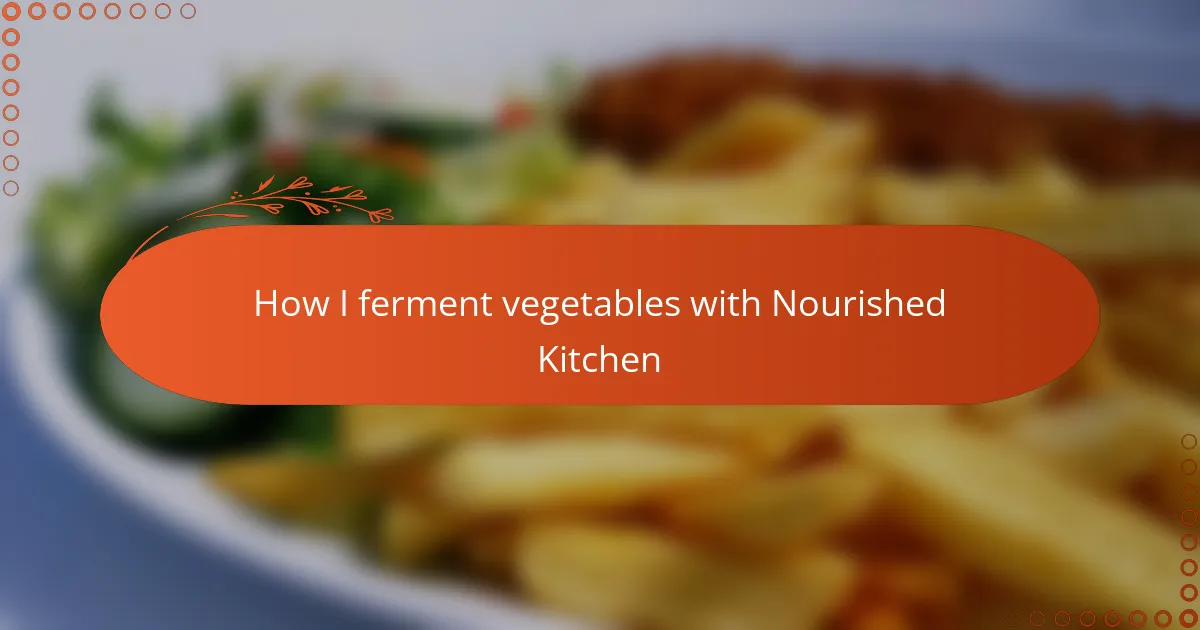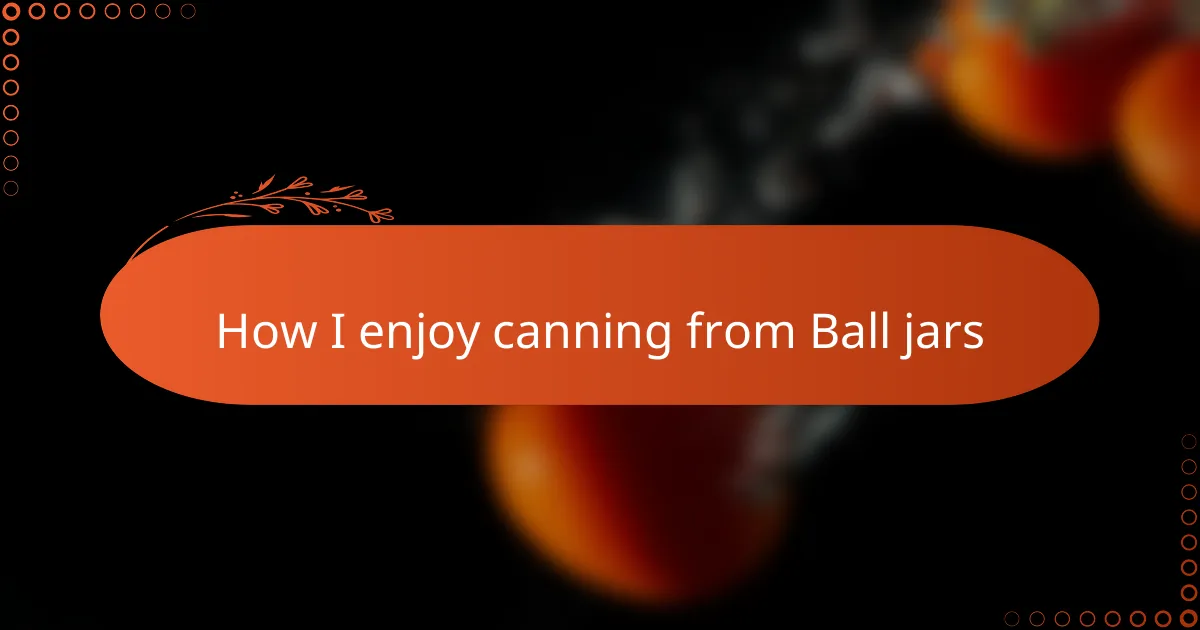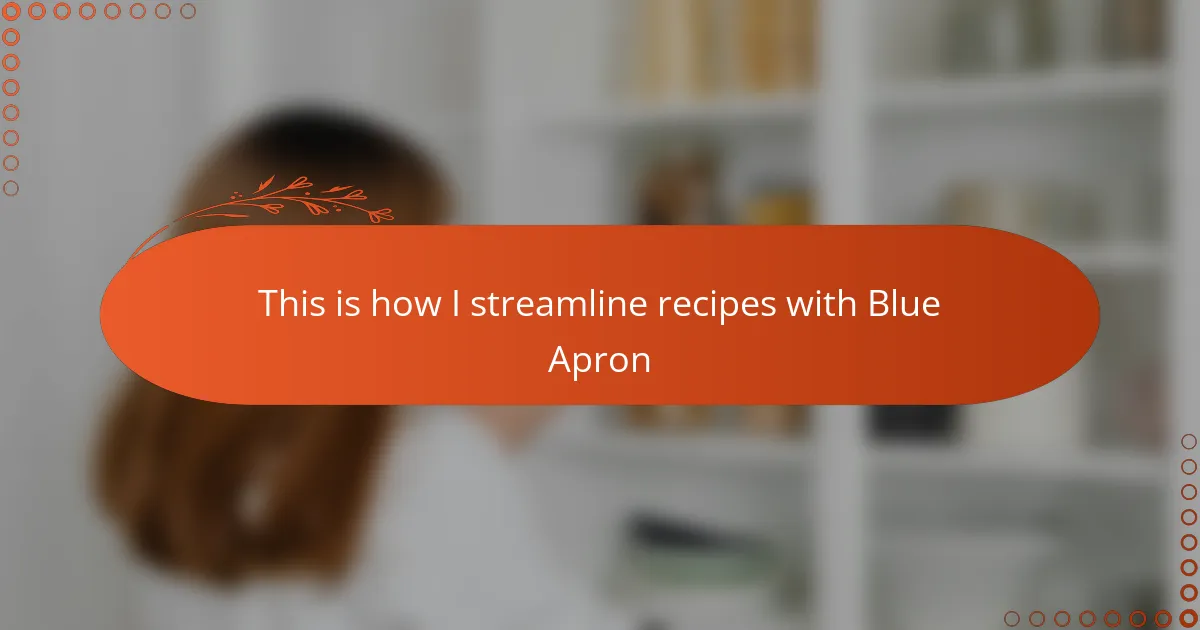Key takeaways
- Fermentation transforms vegetables through natural bacteria, enhancing flavor and promoting gut health.
- Key equipment includes wide-mouth jars, fermentation weights, and breathable lids to ensure proper fermentation.
- Choosing fresh, firm vegetables optimizes the fermentation process and flavor, making each batch unique.
- Patience is crucial; allowing ferments to develop fully can lead to more complex flavors and textures.
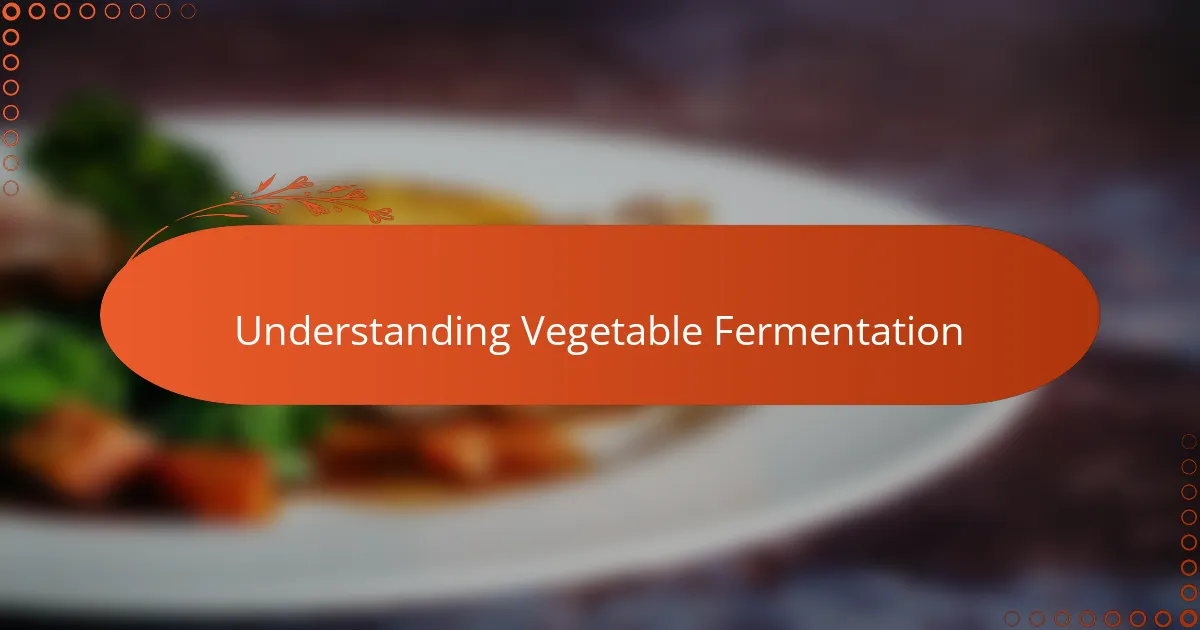
Understanding Vegetable Fermentation
Fermentation has always fascinated me because it’s more than just preserving food—it’s a living process. When vegetables ferment, natural bacteria eat the sugars and produce lactic acid, creating that tangy flavor we all love. Have you ever wondered why a simple cabbage turns into crunchy, flavorful sauerkraut? It’s this magical transformation driven by tiny, beneficial microbes.
What amazes me most is how this age-old technique captures the essence of seasons and soil in every bite. I remember my first attempt at fermenting cucumbers; the wait was nerve-wracking but rewarding. That slow bubbling was like a sign that nature was hard at work, turning humble veggies into something nourishing and alive.
Understanding this process helped me appreciate fermentation not just as cooking, but as a connection to tradition and health. Do you ever think about how something so simple can preserve food and boost your gut health simultaneously? It’s nature’s perfect synergy, and once you see it in action, you realize it’s much easier and more rewarding than it seems.

Essential Equipment for Fermenting
When I first started fermenting, I quickly learned that having the right jars makes all the difference. Wide-mouth glass jars are my go-to because they’re easy to fill and clean, plus you can see the vegetables at work during fermentation. Have you ever tried using a regular container only to find your veggies floating and molding? Avoiding that mess is worth every penny spent on proper jars.
Another tool I can’t live without is a fermentation weight. These little weights keep the vegetables submerged beneath the brine, which is crucial to prevent unwanted bacteria from spoiling the batch. I’ve seen firsthand how skipping this step can lead to off flavors, so investing in a good weight really gives me peace of mind during the process.
Lastly, I always keep a cloth or fermentation lid handy to cover my jars. This allows gases to escape without letting dust or bugs inside—something that’s easy to overlook but vital for a successful ferment. It’s funny how such simple equipment can transform a novice like me into a confident fermenter, knowing that each jar is set up for the best possible outcome.

Choosing the Right Vegetables
Choosing the right vegetables for fermenting has been a game-changer in my kitchen adventures. I quickly realized that some vegetables, like cabbage and cucumbers, naturally lend themselves to fermentation because they have the perfect balance of sugars and water content. Have you ever tried fermenting something dense or watery only to end up with a soggy mess? That taught me the importance of starting with veggies that have firm textures and enough natural sugars to feed the bacteria.
I also like to choose vegetables that are fresh and locally grown whenever possible. It feels more connected to the season and place, plus fresher veggies ferment with better flavor and texture. One time, I used supermarket tomatoes that were a bit bruised, and the batch didn’t turn out as vibrant as usual. Since then, I make it a point to pick crisp, unblemished produce—it really shows in the final taste.
What’s exciting is how experimenting with different vegetables gives each batch a unique character. From hardy carrots to spicy radishes, each brings something special to the jar. It’s like a personal canvas where I decide the outcome based on what’s in my garden or market that week. Have you found a favorite vegetable to ferment yet? For me, those little discoveries keep the process fresh and inspiring every time.
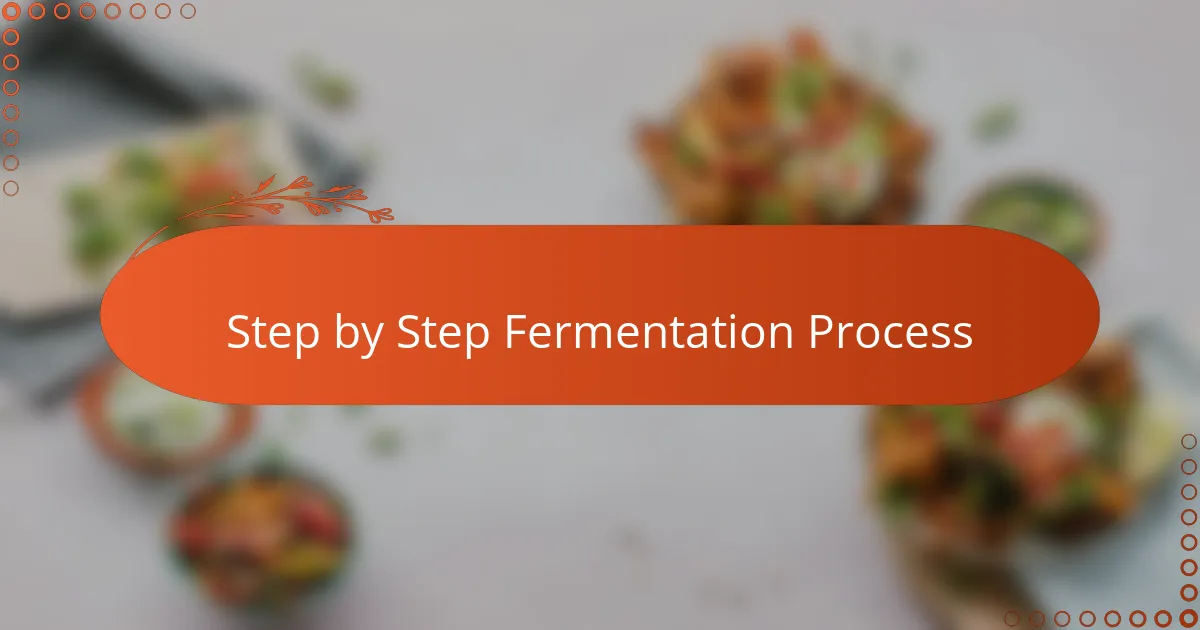
Step-by-Step Fermentation Process
First, I chop the vegetables into bite-sized pieces—uniformity really helps the fermentation happen evenly. Then, I sprinkle them with the right amount of salt; this is key because it not only draws out the veggies’ natural juices but also creates the perfect environment for beneficial bacteria to thrive. Have you ever measured salt by eye and ended up with either a bland or overly salty ferment? Trust me, a kitchen scale or precise measuring spoon takes the guesswork out and leads to consistent, tasty results.
Once salted, I massage the vegetables gently until they start releasing liquid—this brine is what keeps everything submerged and safe from unwanted molds. I remember the first time I skipped this step and ended up with a dry, sad batch that simply didn’t ferment right. Keeping the veggies under the brine is crucial; that’s where fermentation magic happens, so I place a weight on top to ensure they stay fully covered.
After sealing the jar with a breathable lid or cloth, I store it at room temperature, checking daily for bubbles or that pleasant, sour aroma—that’s the good bacteria at work. I usually wait about a week but have learned to trust my senses over time; some batches take longer, and others are ready sooner. Don’t you find it exciting how this slow, living process keeps you connected to your food in such a tangible way? It’s like watching time and nature work together in your own kitchen.

Tips from Nourished Kitchen
One tip from Nourished Kitchen that really stuck with me is the emphasis on patience during fermentation. I used to get impatient, checking jars every hour, but they remind us that fermentation is a slow dance—rushing it only muddles the flavors. Have you ever found that letting a batch rest longer deepens its complexity? I have, and it’s always worth the wait.
Another insight I appreciate is their advice on salt quality. Using unrefined salts, like sea salt or Himalayan pink salt, can make a surprising difference—they contain trace minerals that nurture the fermenting bacteria better than plain table salt. I tried switching salts after reading this and noticed my ferments had a brighter, more balanced flavor. It’s fascinating how such a tiny tweak affects the whole process.
Nourished Kitchen also highlights the importance of trusting your senses throughout fermentation. They suggest sniffing, tasting, and observing rather than rigidly following timelines. I love this approach because it turns fermenting into a personal, intuitive practice rather than a chore. Does that hands-on connection to food remind you why we love homesteading in the first place? It sure does for me.

Common Fermentation Challenges
Fermentation can sometimes feel like a delicate dance with unpredictability. I’ve had batches where the brine turned cloudy or developed an off smell, which made me question if I’d done something wrong. Have you ever wondered why some jars bubble happily while others just sit still, seemingly refusing to ferment? Often, it comes down to factors like temperature fluctuations or insufficient salt, both of which can throw the microbes off balance.
Another challenge I’ve faced is mold appearing on the surface—a scary sight for any fermenter. At first, I panicked, but I learned that a thin film of harmless kahm yeast can form and is not a threat, whereas green or black molds mean the batch needs to be discarded. Watching my fermentations closely has taught me that maintaining cleanliness and keeping vegetables fully submerged are the best defenses against unwelcome invaders.
Sometimes, patience itself is the biggest hurdle. There have been days when I was tempted to stop the process early because the flavor wasn’t sharp enough yet. But I’ve found that trusting the slow rhythm of fermentation usually rewards you with more complex, tangier results. Have you noticed how embracing these little setbacks makes the successes feel even sweeter? For me, each challenge deepens my respect for this ancient craft.
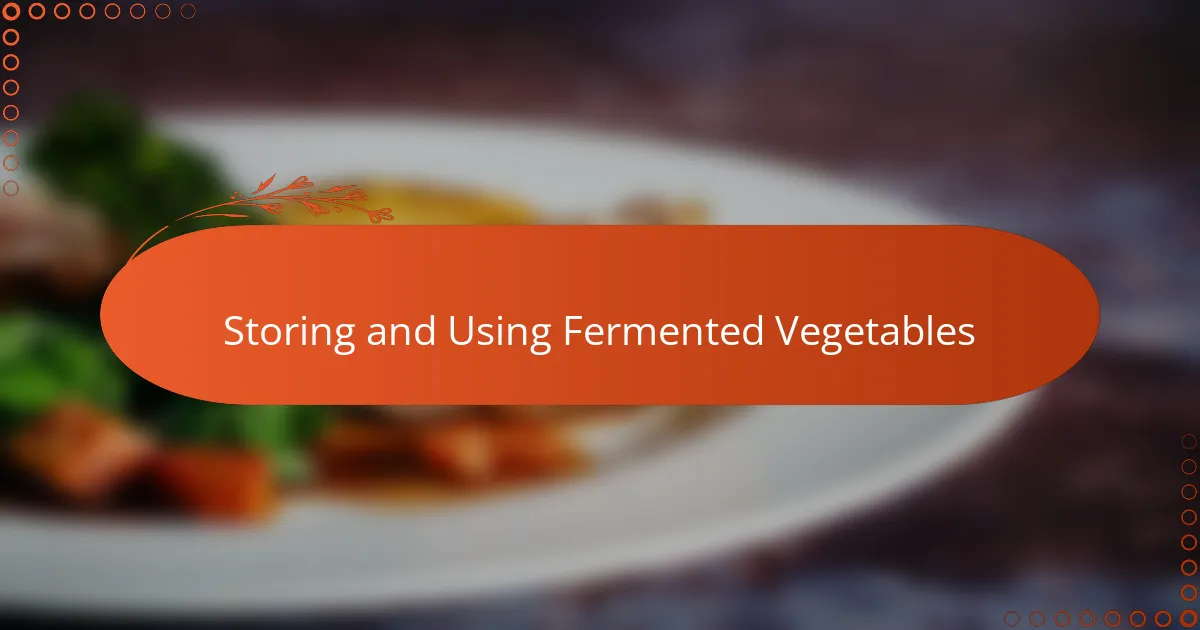
Storing and Using Fermented Vegetables
When it comes to storing my fermented vegetables, I’ve learned that keeping them in the fridge after the initial fermentation slows down the process and locks in that fresh tangy flavor I love. Have you ever left a batch out too long and ended up with veggies that are a bit too sour or mushy? Refrigeration gives me control over the final taste and texture, preserving that satisfying crunch I look forward to.
Using fermented vegetables is one of the most rewarding parts of this whole journey. I often toss them into salads, sandwiches, or even alongside roasted meats to add brightness and zing. Sometimes I catch myself just snacking on them straight from the jar—there’s something comforting about that tangy bite that feels both nourishing and indulgent.
I also like to experiment with how long I leave my ferments before eating them. Early on, I thought the first sign of bubbles meant they were ready, but I’ve discovered that waiting a few extra days deepens the flavor and results in a more complex profile. Isn’t it fascinating how patience in storage translates directly to taste? It makes me appreciate the art in this ancient craft even more.
